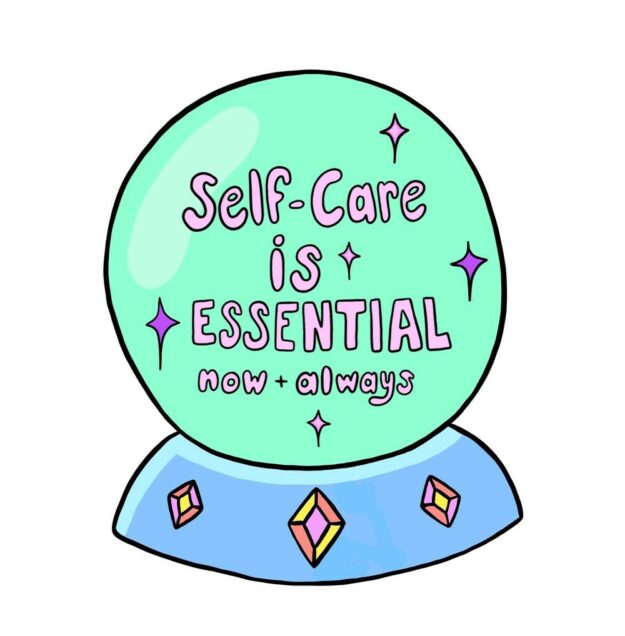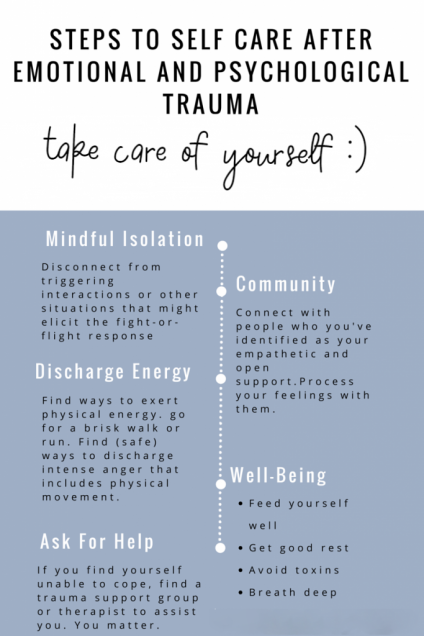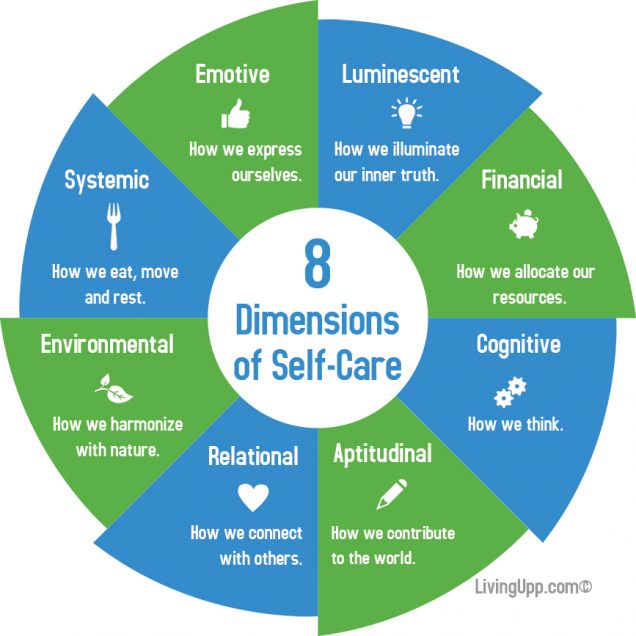Self Care and Trauma
Stacy-Anne Parke ~ CJ720 ~ Trauma and Crisis ~ Blog Post

You deserve to enjoy life just as much as anyone else!
You may not know what good self-care looks like, but it forms the backbone of your physical and emotional well being. It encourages progress and healing. It is essential in the maintenance of a healthy relationship with yourself. Sometimes it’s as simple as getting enough sleep, waking up and getting out of bed, brushing your teeth, and providing your body with the right nutrients it needs. Other times self-care can manifest itself in taking walks, yoga (movement), hanging out with friends or not hanging out with friends, relaxing, expression, and listening to yourself.
How do you know you need to practice better self-care? Well, you may:
- Sleep too much!
- Or not sleep at all.

Retrieved from: Justjasmineblog.com Later modified by me. - Over-schedule.
- Have a poor relationship with food.
- Abuse alcohol and substances
- Feel constant stress.
- Feel Helpless
Trauma is overwhelming and often the relationships between your mind and surroundings are heightened- and maybe even painted a shade of grey. Trauma survivors often feel detached, ”the essence of trauma is feeling godforsaken, cut off from the human race” (Van der Kolk, 2014). However, your life deserves to be in color, full of turquoise, light lilac and ignited red. Taking care of yourself is life-saving, it isn’t a luxury but it sure does feel luxurious . Especially for trauma survivors, it is important to engage in “activities that lower the physiological adrenal surge from trauma” ( De Lorenzo, 2018). Engaging in the present reduces those surges.
The neuroplasticity of your brain continues to develop past childhood; at any age, you can re-heal, grow, and learn. How incredible and hopeful is that? This can be accomplished through safe relationships, improved adaptive thinking, self-regulation, learning, and social skills, all of which are facets of many self-care plans (Masten, 2014; Matto, Strolin-Goltzman, & Ballan, 2014). Emotions help us to engage in actions and behaviors. Love encourages us to love, fear encourages detachment, while anger can culminate into aggression, violence, and emotional harm. Trauma suspends those emotions and instead leaves the mind and body feeling paralyzed, absolutely stuck in time. With the incredible tool of plasticity it is still hard for our rational brains to take care of ourselves, “the rational mind, while able to organize feelings and impulses, is not well equipped to abolish emotions, thoughts, and impulses” (Van der Kolk, 2009). For example, individuals with PTSD are usually out of touch with their physical sensations; mindfulness can help mend that relationship by allowing the individual to become more aware.
Starting with children it’s important to equip them with the right tools for self-management. For traumatized and neglected children this can be established in schools. In fact, schools can be a gateway to creating resilience. Thus, it is imperative
“to receive a good education in schools where they are seen and known, where they learn to regulate themselves, and where they can develop a sense of agency. At their best, schools can function as islands of safety in a chaotic world. They can teach children how their bodies and brains work and how they can understand and deal with their emotions. Schools can play a significant role in instilling the resilience necessary to deal with the traumas of neighborhoods or families … to be the places where children are taught self-leadership and an internal locus of control” (Van der Kolk, 2014)
For traumatized adults, it is imperative that there are established dependable and healthy relationships and if not eliminating toxic ones are ideal. Addressing the dimensions of self-care through those relationships can then do wonders.

Self-care shouldn’t fall solely on the individual either. Friends and family can encourage better stress-management practices; Clinicians have a responsibility of encouraging healthy practices with their clients and themselves (vicarious trauma). Small assignments that turn into habits throughout a course of therapy can lead to momentous changes in behavior and self-worth. Improvements are made in energy levels, productivity, fulfillment/satisfaction, along with overall well-being.
Balancing psychological needs and maintaining a sense of well-being requires effort, consistency, and patience. Not only is there an ethical need for self-care for therapists, but there is a paramount necessity for it in order to live wholly. We essentially have all of the parts to be effectively be present and manage stress; however, self-care keeps those parts in shape and running.
25 ways to practice self-care
- hydrate
- walk
- dance
- listen to music
- shower/bath
- sleep
- change your clothes
- yoga
- clean
- wash your face
- read a book
- write a poem
- journal
- light a candle
- talk to a friend
- talk to many friends
- feel- cry, smile, laugh
- color
- practice forgiveness
- practice acceptance
- set priorities
- therapy
- cook
- surround yourself with your favorite smells
- try something new
References
Masten, A. S. (2014). Ordinary magic: resilience in development. New York: Guilford Press.
Matto, H. C., Strolin-Goltzman, J., & Ballan, M. S. (2014). Neuroscience for social work: current research and practice. New York: Springer.
Van der Kolk, B. (2009). Yoga and Post-traumatic stress disorder [Interview]. Integral Yoga Magazine, 12-13.
Van der Kolk, B. (2014). The body keeps the score: Brain, mind, and body in the healing of trauma. New York: Viking.